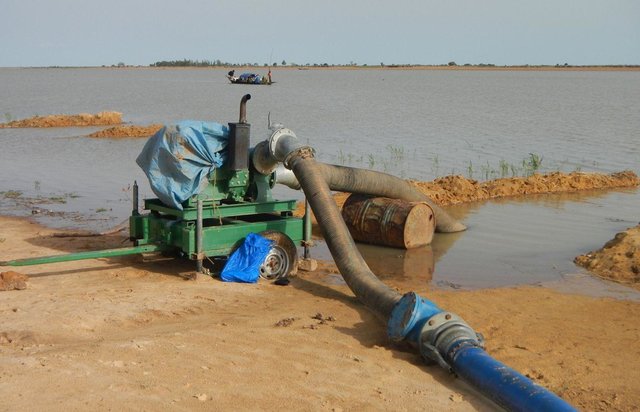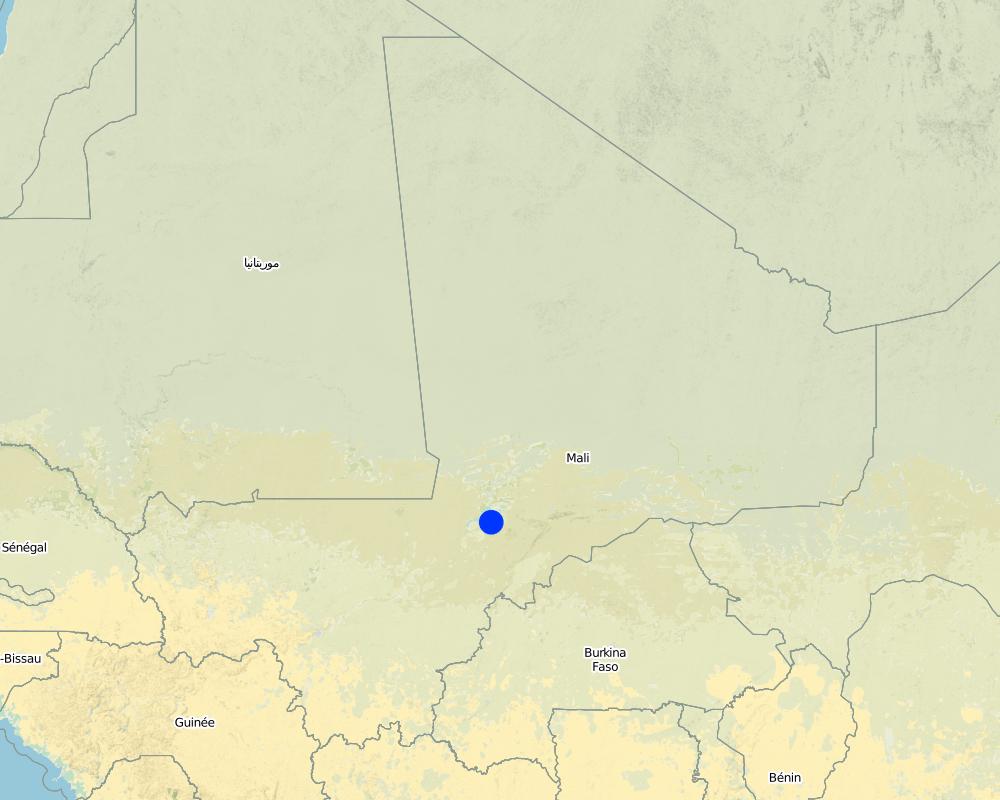Participatory approach to small-scale irrigation [مالي]
- تاريخ الإنشاء:
- تحديث:
- جامع المعلومات: Dieter Nill
- المحرر: –
- المُراجع: Laura Ebneter
Approche participative dans l’irrigation de proximité
approaches_2513 - مالي
عرض الأقسام
توسيع الكل طي الكل1. معلومات عامة
1.2 تفاصيل الاتصال بالأشخاص الرئيسيين لمصدر المعلومات والمؤسسات المعنية بتقييم وتوثيق النهج
متخصص في الإدارة المستدامة للأراضي:
Kone Mamadou Gallo
gallokone@yahoo.fr
IPRO-DB Bélédougou
مالي
متخصص في الإدارة المستدامة للأراضي:
Schneider Ralf
ralf_schneider5@hotmail.com
IPRO-DB Bélédougou
مالي
متخصص في الإدارة المستدامة للأراضي:
Ouologuem Abass
ouologuemabass@yahoo.fr
IPRO-DB Bélédougou
مالي
اسم المشروع الذي سهّل توثيق/تقييم النهج (إذا كان ذلك على صلة)
Le Projet Irrigation de Proximité au Pays Dogon et dans le Bélédougou, Mali (IPRO-DB)اسم المؤسسة (المؤسسات) التي سهلت توثيق/تقييم النهج (إذا كان ذلك على صلة)
Deutsche Gesellschaft für Internationale Zusammenarbeit (GIZ) GmbH (GIZ) - ألمانيا1.3 الشروط المتعلقة باستخدام البيانات الموثقة من خلال WOCAT
متى تم تجميع البيانات (ميدانيا)؟:
01/07/2012
يوافق جامع المعلومات والشخص (لاشخاص) الرئيسي لمصدر المعلومات على الشروط المتعلقة باستخدام البيانات الموثقة من خلال WOCAT:
نعم
1.4 المراجع الخاصة باستبيان(استبيانات) تقنيات الإدارة المستدامة للأراضي

Irrigation using a Californian network [مالي]
A micro-irrigation system to use water more efficiently and increase yields
- جامع المعلومات: Dieter Nill

Village irrigation schemes developed using the PMN/IPRODI approach [مالي]
Village irrigation schemes (VISs) help to control the water supply and significantly increase yields.
- جامع المعلومات: Dieter Nill
2. وصف نهج الإدارة المستدامة للأراضي
2.1 وصف موجز للنهج
The participatory approach to small-scale irrigation ensures skills and expertise are transferred to scheme beneficiaries and other stakeholders.
2.2 وصف تفصيلي للنهج
وصف تفصيلي للنهج:
The participatory approach to small-scale irrigation (SI) ensures skills and expertise are transferred to scheme beneficiaries and other stakeholders. This enhances the value of investments and the sustainability of installations.
Direct beneficiaries (villagers) and indirect beneficiaries (technical services, communes) are involved before, during and after the installation of irrigation systems in order to ensure the sustainability of the schemes and a long-term return on investment.
Firstly, all the actors involved in the schemes are identified. Beneficiaries’ concerns are taken into account and the participation of relevant actors is ensured throughout the process. The following factors are essential when applying this approach: 1) the commitment of beneficiaries to engage in the project approach; 2) an explicit request made by beneficiaries for the scheme in question; 3) an agreement to relay the content of meetings to all beneficiaries; 4) an awareness of potentially significant constraints such as property issues, a lack of villagers available to provide labour, and the payment of financial contributions.
The participatory approach enhances the sustainability of investments, while the cost of participation remains low. The prevention and management of conflicts, the commitment of beneficiaries to schemes and the uptake of construction and management techniques by beneficiaries are all factors that contribute to sustainability.
The support structure (IPRO-DB) offers assistance in identifying the actors to involve, organises meetings, monitors information events for villagers (known as restitution sessions) and provides financial support. The village committee participates in all meetings, keeps villages informed, acts as an intermediary between associations, support structures and the community, and organises meetings. Farmers’ associations constitute sources of information, identify needs, draw up bylaws, contribute labour and funds to activities and participate in decision-making in village councils. Technical services provide advisory support and constitute sources of information. The commune provides information, raises the awareness of the actors involved, invites beneficiaries to the exchange meetings, identifies the actors involved and approves villagers’ requests.
The approach was implemented in eight villages with a combined population of around 9,240 people. The schemes cover a total area of around 766 hectares of farmland. Duration of application: Since 2005.
2.5 البلد/المنطقة/المواقع التي تم تطبيق النهج فيها
البلد:
مالي
المنطقة/الولاية/المحافظة:
Mali
مزيد من التفاصيل حول الموقع:
Kambila, Nonkon, Nossombougou, N’Tjiba, Kolokani, Tioribougou
Map
×2.6 تواريخ بدء وإنهاء تنفيذ النهج
أشر إلى سنة البدء:
2005
2.7 نوع النهج
- قائم على مشروع/برنامج
2.8 الغايات/الأهداف الرئيسية للنهج
The participatory approach to small-scale irrigation (SI) ensures skills and expertise are transferred to scheme beneficiaries and other stakeholders. This enhances the value of investments and the sustainability of installations. Direct beneficiaries (villagers) and indirect beneficiaries (technical services, communes) are involved before, during and after the installation of irrigation systems in order to ensure the sustainability of the schemes and a long-term return on investment.
The SLM Approach addressed the following problems: lack of skills and expertise, lack of involvement of beneficiaries before, during and after the installation of irrigation systems
2.9 الظروف التي تمكن أو تعيق تنفيذ التقنية/التقنيات المطبقة بموجب النهج
الإطار المؤسساتي
- معيق
lack of involvement of beneficiaries
Treatment through the SLM Approach: Direct beneficiaries (villagers) and indirect beneficiaries (technical services, communes) are involved before, during and after the installation of irrigation systems in order to ensure the sustainability of the schemes and a long-term return on investment.
المعرفة حول الإدارة المستدامة للأراضي، والوصول إلى الدعم الفني
- معيق
lack of skills and expertise,
Treatment through the SLM Approach: participatory approach to small-scale irrigation (SI) ensures skills and expertise are transferred to scheme beneficiaries and other stakeholders
3. المشاركة وأدوار الأطراف المعنية
3.1 أصحاب المصلحة المعنيون بالنهج وأدوارهم
- مستخدمو الأراضي المحليون/المجتمعات المحلية
- متخصصون في الإدارة المستدامة للأراضي / مستشارون زراعيون
- منظمة غير حكومية
- الحكومة المحلية
- الحكومة الوطنية (المخططون، صانعو القرار)
3.2 انخراط مستخدمي الأراضي المحليين/المجتمعات المحلية في المراحل المختلفة للنهج
| انخراط مستخدمي الأراضي المحليين/المجتمعات المحلية | حدد من شارك وصف الأنشطة | |
|---|---|---|
| المبادرة/التحفيز | سلبي | |
| التخطيط | تفاعلي | |
| التنفيذ | تفاعلي | |
| الرصد/التقييم | تفاعلي | |
| Research | سلبي |
3.4 اتخاذ القرار بشأن اختيار تقنية/تقنيات الإدارة المستدامة للأراضي
حدد من الذي قرر اختيار التقنية/التقنيات التي سيتم تنفيذها:
- متخصصون في الإدارة المستدامة للأراضي بشكل أساسي، بعد التشاور مع مستخدمي الأراضي
اشرح:
Decisions on the method of implementing the SLM Technology were made by mainly by SLM specialists with consultation of land users
4. الدعم الفني وبناء القدرات وإدارة المعرفة
4.1 بناء القدرات/التدريب
هل تم تقديم التدريب لمستخدمي الأراضي / الأطراف المعنيين الآخرين؟:
نعم
حدد من تم تدريبه:
- مستخدمو الأراضي
شكل التدريب:
- في العمل
- اجتماعات عامة
- دورات
4.2 خدمة استشارية
هل يملك مستخدمو الأراضي وصولا إلى خدمة استشارية؟:
نعم
حدد ما إذا كانت الخدمة الاستشارية متوفرة:
- في حقول مستخدمي الأراضي
وصف/تعليقات:
Advisory service is quite adequate to ensure the continuation of land conservation activities
4.3 تعزيز المؤسسات (التطوير التنظيمي)
هل تم إنشاء أو تعزيز مؤسسات من خلال هذا النهج؟:
- نعم، باعتدال
حدد المستوى (المستويات) التي تم فيها تعزيز أو إنشاء المؤسسات:
- محلي
حدد نوع الدعم:
- مالي
- بناء القدرات/التدريب
- معدات
4.4 الرصد والتقييم
هل يشكل الرصد والتقييم جزءا من النهج؟:
نعم
التعليقات:
technical aspects were ad hoc monitored by project staff through observations
socio-cultural aspects were ad hoc monitored by project staff through observations
no. of land users involved aspects were ad hoc monitored by project staff through observations
management of Approach aspects were ad hoc monitored by project staff, land users through observations
There were no changes in the Approach as a result of monitoring and evaluation
There were no changes in the Technology as a result of monitoring and evaluation
4.5 البحوث
هل كانت البحوث جزءًا من النهج؟:
نعم
حدد المواضيع:
- علم الاجتماع
- تكنولوجيا
أعط تفاصيل إضافية وأشر إلى من قام بالبحوث:
Research was carried out on station
5. التمويل والدعم المادي الخارجي
5.1 الميزانية السنوية لمكون الإدارة المستدامة للأراضي في النهج المذكور
التعليقات (على سبيل المثال المصادر الرئيسية للتمويل/الجهات المانحة الرئيسية):
Approach costs were met by the following donors: international (IPRO-DB): 100.0%
5.2 الدعم المالي/المادي المقدم لمستخدمي الأراضي
هل حصل مستخدمو الأراضي على دعم مالي/ مادي لتنفيذ التقنية/ التقنيات؟:
نعم
5.3 إعانات لمدخلات محددة (بما في ذلك العمالة)
إذا كان العمل من قبل مستخدمي الأراضي مدخلاً جوهريًا، فهل كان:
- تطوعي
5.4 الائتمان
هل تم توفير ائتمان في إطار نهج أنشطة الإدارة المستدامة للأراضي؟:
كلا
6. تحليل الأثر والتصريحات الختامية
6.1 آثار النهج
هل ساعد النهج مستخدمي الأراضي على تنفيذ وصيانة تقنيات الإدارة المستدامة للأراضي؟:
- لا
- نعم، قليلا
- نعم، باعتدال
- نعم، إلى حد كبير
The participatory approach ensures skills and expertise are transferred to scheme beneficiaries and other stakeholders. This enhances the value of investments and the sustainability of installations.
هل ساهم النهج في تمكين الفئات المحرومة اجتماعيا واقتصاديا؟:
- لا
- نعم، قليلا
- نعم، باعتدال
- نعم، إلى حد كبير
Did other land users / projects adopt the Approach?
- لا
- نعم، قليلا
- نعم، باعتدال
- نعم، إلى حد كبير
The approach was implemented in eight villages with a combined population of around 9,240 people. The schemes cover a total area of around 766 hectares of farmland. Duration of application: Since 2005
Did the Approach lead to improved livelihoods / human well-being?
- لا
- نعم، قليلا
- نعم، باعتدال
- نعم، إلى حد كبير
The participatory approach facilitates understanding among the communes and the quick delivery of schemes requested by the commune. The labour and financial contribution provided reduces the investment costs of schemes. The likelihood of possible conflicts is reduced.
Did the Approach help to alleviate poverty?
- لا
- نعم، قليلا
- نعم، باعتدال
- نعم، إلى حد كبير
6.2 المحفز الرئيسي لقيام مستخدمي الأراضي بتنفيذ الإدارة المستدامة للأراضي
- زيادة الإنتاج
- زيادة الربح (القدرة)، وتحسين نسبة التكلفة إلى العائد
- الانتماء إلى حركة/ مشروع/ مجموعة/ شبكات
6.3 استدامة أنشطة النهج
هل يمكن لمستخدمي الأراضي المحافظة على استدامة ما تم تنفيذه من خلال النهج (بدون دعم خارجي)؟:
- نعم
6.4 نقاط قوة/مزايا النهج
| نقاط القوة/ المزايا/ الفرص من وجهة نظر جامع المعلومات أو غيره من الاشخاص الرئيسيين لمصدر المعلومات |
|---|
| The only costs incurred relate to catering and venue charges for the training workshops and study trips. The cost of participating in study trips remains very low, except in cases where there is no local village with expertise in the subject in question. |
|
The participatory approach facilitates understanding among the communes and the quick delivery of schemes requested by the commune. |
| The labour and financial contribution provided reduces the investment costs of schemes. |
| The likelihood of possible conflicts is reduced. |
| skills and expertise are transferred to scheme beneficiaries |
| enhances the value of investments and the sustainability of installations |
| Direct beneficiaries (villagers) and indirect beneficiaries (technical services, communes) are involved before, during and after the installation of irrigation systems in order to ensure the sustainability of the schemes and a long-term return on investment |
7. المراجع والروابط
7.1 طرق جمع/مصادر المعلومات
- زيارات ميدانية، مسوحات ميدانية
- مقابلات مع مستخدمي الأراضي
7.2 المراجع للمنشورات المتاحة
العنوان، المؤلف، السنة، النظام القياسي الدولي لترقيم الكتب ISBN:
Manual of Good Practices in Small Scale Irrigation in the Sahel. Experiences from Mali. Published by GIZ in 2014.
متاح من أين؟كم التكلفة؟:
http://star-www.giz.de/starweb/giz/pub/servlet.starweb
الروابط والوحدات المواضيعية
توسيع الكل طي الكلالروابط

Irrigation using a Californian network [مالي]
A micro-irrigation system to use water more efficiently and increase yields
- جامع المعلومات: Dieter Nill

Village irrigation schemes developed using the PMN/IPRODI approach [مالي]
Village irrigation schemes (VISs) help to control the water supply and significantly increase yields.
- جامع المعلومات: Dieter Nill
الوحدات المواضيعية
لا يوجد وحدات مواضيعية


